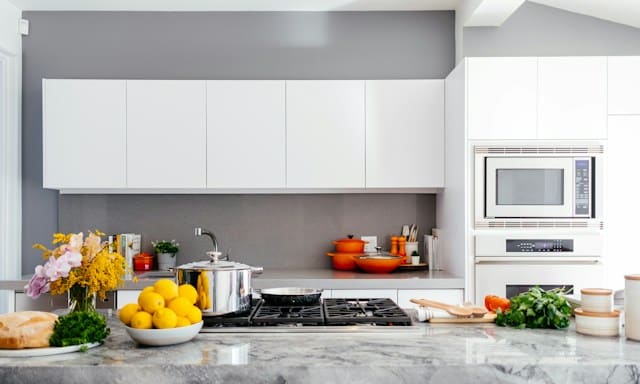In today’s digital age, the word ‘smart’ is not just a term limited to phones and watches. It has made its way into our kitchens, revolutionizing the way we cook and manage our homes. With smart kitchen appliances, you can streamline your cooking process, enhance your culinary skills, and even save on energy. From automated cooking devices to voice-controlled systems, the possibilities are endless. But how do you integrate these smart devices into your existing kitchen set-up? Read along to discover some of the best methods.
Unleashing the Power of Connectivity and Automation
Before we delve into the integration process, it’s essential to understand how these smart kitchen appliances work. These devices leverage Internet of Things (IoT) technology, which allows them to connect and communicate with each other through the internet.
A voir aussi : How to Create an Energy-Efficient Laundry Room That Saves Water and Electricity?
With smart kitchen appliances, you can preheat your oven from your smartphone while you’re still at the grocery store, or have your coffee ready when you wake up. Some refrigerators can even alert you when you’re running out of an ingredient, while others can lock themselves to keep your food secure.
These appliances are all about providing convenience and efficiency. They allow you to automate routine tasks, giving you more time to focus on creating delicious meals. Plus, they are energy efficient, leading to significant savings on your utility bills over time.
A lire en complément : What’s the Best Way to Design a Small Home Office That Maximizes Space and Functionality?
Choosing the Right Smart Appliances for Your Kitchen
The first step in integrating smart appliances into your kitchen is choosing the right devices. Nowadays, there are a plethora of smart cooking devices available, all boasting different features and functionalities. It’s easy to get overwhelmed and splurge on appliances you might not need.
When selecting smart kitchen appliances, consider your cooking habits, space, and budget. Look for appliances that could genuinely make your life easier and not just add to the clutter in your kitchen. Prioritize devices that offer energy efficiency and security features.
For instance, if you’re a coffee lover, an automated coffee maker would be a great addition. For those who love baking, a smart oven with temperature and time control could be the best choice. On the other hand, if you’re concerned about food safety, a smart refrigerator that alerts you when food is about to expire would be a worthwhile investment.
Integrating Smart Appliances: The Role of a Central Hub
One of the challenges of having multiple smart appliances is managing them all. This is where a central hub comes in handy. A hub serves as the heart of your smart kitchen, allowing you to control all your devices from a single platform.
Most smart appliances are compatible with popular home automation systems like Amazon Alexa, Google Home, or Apple’s HomeKit. These platforms not only provide voice control capabilities but also allow for seamless integration of different devices.
Setting up a central hub will require some technical know-how. However, most brands provide detailed guides and customer support to help you through the process. Once set up, you can control your devices through a smartphone app or through voice commands, further enhancing your cooking experience.
Customizing Your Smart Kitchen Experience
No two cooks are alike, and neither should two smart kitchens be. The beauty of integrating smart appliances into your kitchen is the level of customization they offer.
You can set up your devices to suit your cooking style and preferences. For instance, you can program your smart oven to start preheating at a specific time, or your coffee maker to have a hot cup ready when your alarm rings. Some advanced refrigerators even allow you to change the temperature settings based on the type of food stored.
Remember, the goal is to create a seamless cooking experience that catifies to your needs. So, don’t hesitate to tweak settings and experiment until you find what works best for you.
Keeping Up with Technology: Updating and Maintaining Your Smart Kitchen
Just like any other technology, smart appliances also require regular updates and maintenance to keep functioning optimally. The manufacturers often release software updates that improve performance, add new features, or fix bugs.
Maintaining your smart kitchen also includes keeping an eye on the physical well-being of the appliances. Regularly clean your devices, check for any damages, and schedule professional services if needed.
Remember, integrating smart appliances into your kitchen is more than just a one-time set-up. It’s an ongoing process that requires your attention and care. But with the convenience, efficiency, and enhanced control they offer, it’s certainly worth the effort.
Advanced Features and Future Trends in Smart Kitchen Appliances
While we’ve already touched on some amazing features of smart kitchen appliances such as automated cooking, remote control, and energy efficiency, there’s more to explore. The smart appliances market is continually evolving, introducing innovative features that further optimize your kitchen automation experience.
For instance, some smart ovens now come with built-in cameras, allowing you to monitor your food from your smartphone. Some smart refrigerators have transparent touch screens, enabling you to see inside without opening the door. Many appliances also offer recipe suggestions based on the ingredients you have, making meal planning a breeze.
There’s also a growing trend of pairing smart kitchen appliances with voice assistants like Amazon’s Alexa or Google Home. This allows for hands-free operation, which can be a real asset when you’re dealing with hot pots and pans or sticky dough. With voice commands, you can set timers, adjust temperatures, or turn on your smart lighting without having to touch anything.
Moreover, many smart appliances are now compatible with smart thermostats. This allows them to adjust their energy usage based on the overall energy consumption of your home, leading to increased energy efficiency.
As technology evolves, we can expect more advanced features and trends to emerge in the smart appliances market. It’s important to keep an eye on these trends to ensure your smart kitchen remains up-to-date and provides the best possible cooking experience.
Conclusion: Transforming Your Kitchen with Smart Technology
Integrating smart appliances into your kitchen is a big step towards creating a smart home. Whether it’s a smart oven that lets you bake perfectly every time, a smart refrigerator that helps reduce food waste, or automated coffee makers that ensure you never miss your morning caffeine fix, these devices can truly transform your kitchen experience.
However, the journey doesn’t end at purchasing and installing these appliances. To truly reap the benefits of smart technology in your kitchen, it’s crucial to understand the features of your devices, customize them according to your needs, and stay updated with the latest trends and updates.
Remember, the goal is not to fill your kitchen with the most advanced gadgets, but to create a seamless, efficient, and enjoyable cooking environment. With careful planning, the right devices, and a bit of tech-savvy, you can create the smart kitchen of your dreams.
So, are you ready to take your kitchen to the next level? The world of smart appliances awaits you. Happy cooking!






